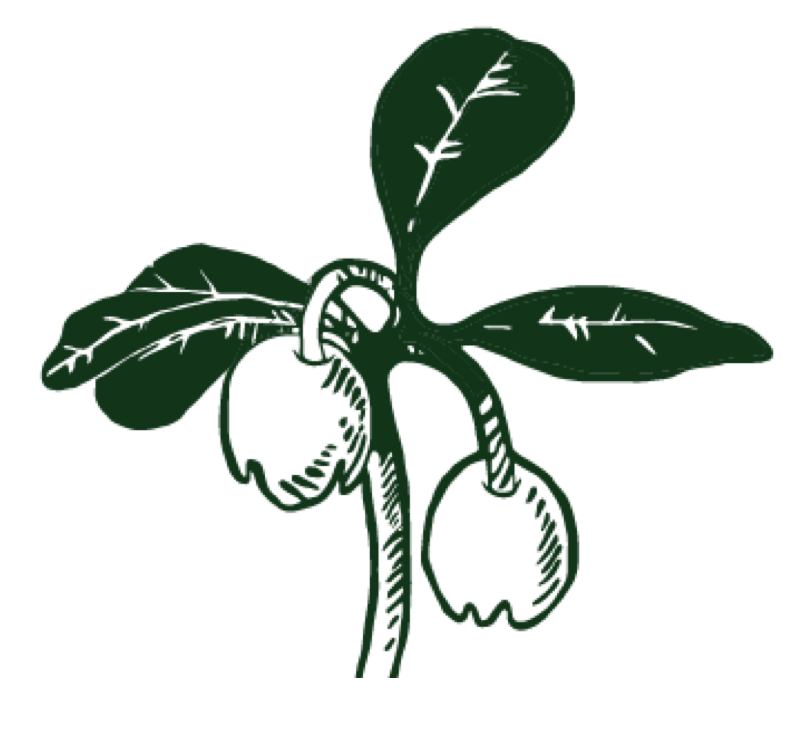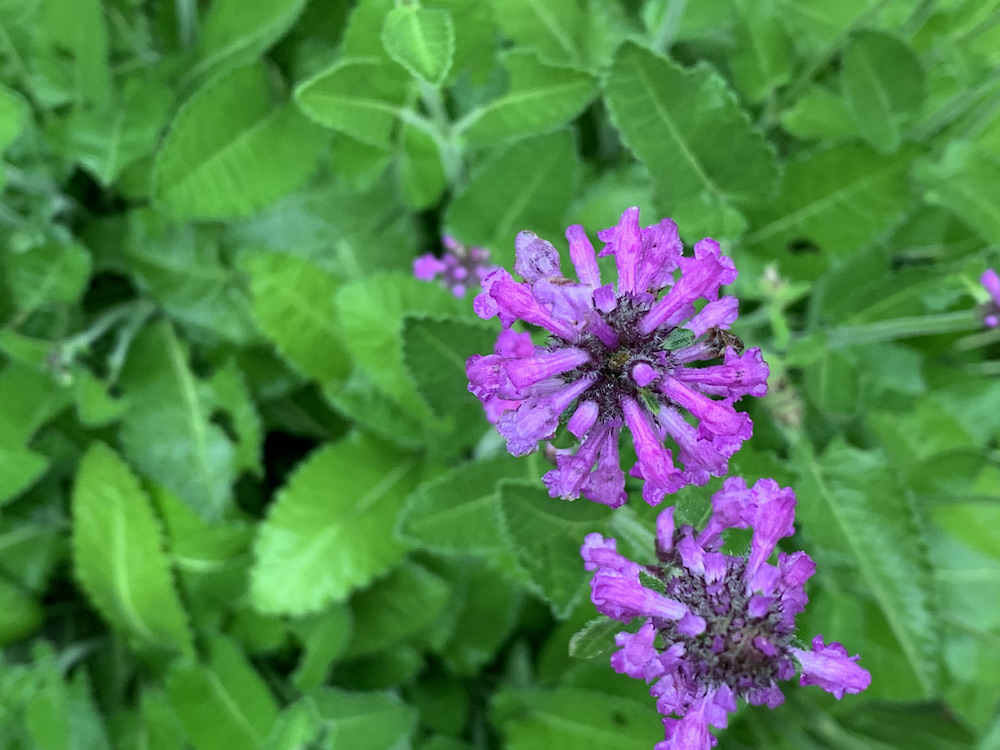Student Monograph ~
Wood Betony
This Materia Medica assignment (new, more in-depth style) was written by Tammy Lesueur
with additional input from Maria Noel Groves and Ruth Droescher.
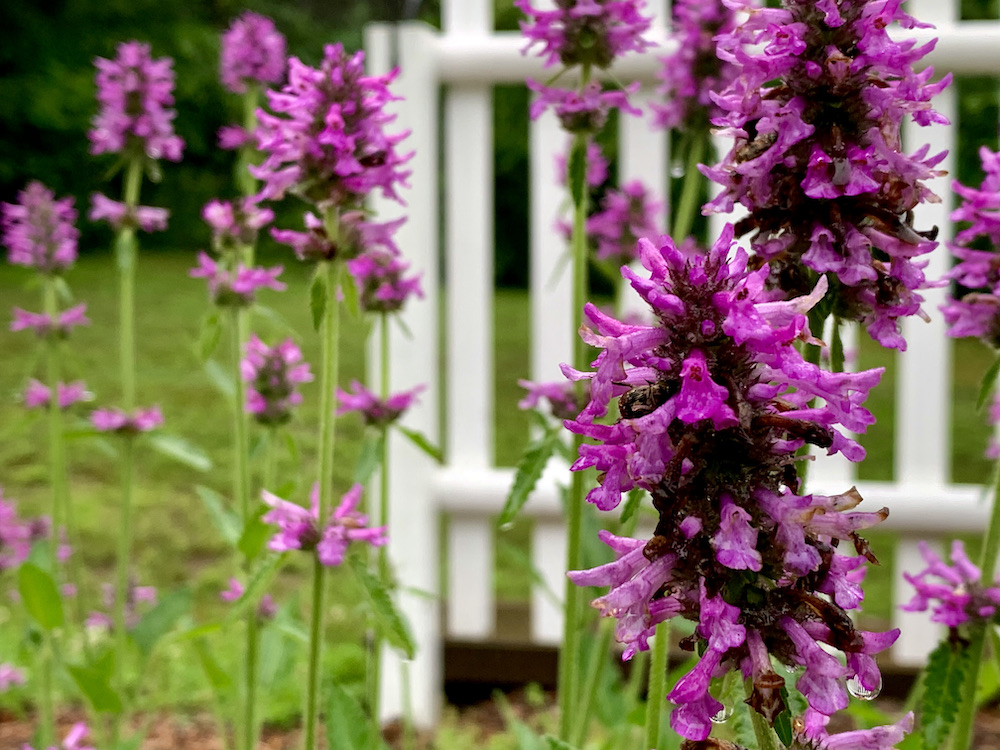
Common Name: Wood Betony, Betony (these names may also refer to Pedicularis species and Stachys lavendulifolia)
Sometimes called Heal All (which may also refer to self heal, Prunelle vulgaris), Hedge Nettle, or Bishopswort
Latin name: New name is Betonica officinalis,
old names are Stachys officinalis (2,3,4,5,6) and Stachys betonica (1)
Family: Lamiaceae (Mint Family) (1,2,3,4,5,6)
Part(s) Used: Aerial Parts, flowers, and leaves (1,2,3,4,5)
Key Actions: Nervine relaxant, vulnerary, astringent, bitter tonic, Carminative, anti-spasmodic, expectorant.
Flavor: Mild bitter, (1,2) aromatic, earthy, astringent, slightly warming, sweet. (2) nice, there is something almost but not quite minty about it, kind of like skullcap
Energetics: Slightly warming, drying, relaxant, tonic-astringent, stimulant (2) I think of it as cooling, relaxing and grounding but there’s plenty of room for debate with the energetics of this herb (especially if working with different herbal medicine systems) - Thomas Easley shares my view on these energetics, too.
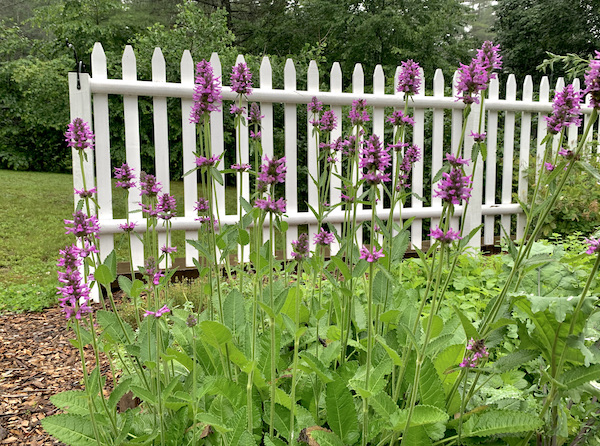
Identification/Growth: Wood betony does will if grown in average to medium, well-drained soil and full sun. It is a fast-growing bush like plant that is characterized by its brilliant blooms. Its flowers range in color from white to pink to deep purple and blooms from June to August. Wood betony is part of the mint family and has many dense, hairy, scalloped dark green leaves similar in appearance to lamb’s ears. The flowering stems grow nit to twelve inches tall from the main basal clump at its center. The tubular shaped flowers lint the length of the flowering stems. It is best to directly sow seed into prepared soil outside in the late summer or early fall. After a period of stratification over the winter season, seedlings will emerge in the early spring. I have this plant growing in my own herb garden, once it blooms it is a standout and people always ask me what kind of plant it is. Like most plants in the mint family, the abundance of purple flowers make it a great pollinator plant as well – particularly for native bees. It will self-sow but unlike other mint plants it will not take over your garden. (5) yes – it might self-seed enthusiastically but unlike most mints does not send out lots of extended roots.
Beware that another plant is also called betony and wood betony, its Pedicularis. They are not related and totally different plants. Pedicularis grows in the Pacific Northwest and can be wildcrafted. Both plants are use for pain. (1,2)
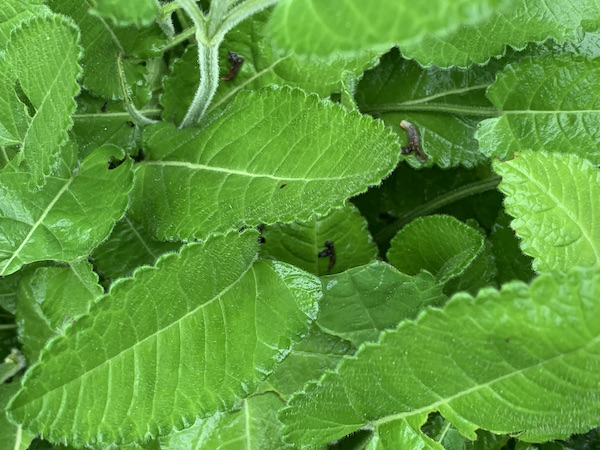
Harvesting/Preparation/Dose: Harvest the leaves any time and the flowers when they are newly opened and happy. You can use this plant fresh or dried. (1,2)
- Tea: 1 heaping tsp of dried herb to one cup/infusion. Although I have used the fresh leaves in an infusion as well. Drink 1 to 3 cups daily. (1,2)
- Tincture: Fresh use both the flowers and the leave.
- Fresh 1:2 in 95 percent alcohol or dried 1:5 in 50-60% alcohol. (1.2) 1 to 3 ml 1-3- times a day, solo or in a blend.
- Flower Essence: The flowers are so beautiful I made a flower essence out of the betony flowers. I use it in my calming tea blend.
- Food: As a fresh or dried plant it makes a nice tea or bitter tonic.
Medicinal Uses:
Nervine: Wood Betony is a nervine, it has a gentle relaxant effect upon the nervous system. It has long been used to ease mild states of unease, tension, and anxiety, and soothes headaches while at the same time providing a deeper level of nourishment and strength to the nerve. (1,2,3)
Vulnerary/Astringent: It has astringent properties, and this makes it highly beneficial wound healing agent as a gentle first aid medicine for general cuts, scrapes and wounds. The vulnerary medicine can be a possible remedy for all manner of wounds in the digestive system, such as ulcer and leaky gut. (1)
Bitter Tonic and Carminative: Because of its bitter properties it has a positive effect on the digestive system. Its increases the secretions of the liver, gallbladder, pancreas, stomach, small and large intestine. This makes it a useful remedy to consider in digestive formulations, especially using it nervine action. (1) Because of its mild antispasmodic property, it can be used to calm cramping, bloating. Gas and colic. Wood Betony exerts a mild relaxant effect upon the smooth muscles, and even skeletal muscles, specifically easing the neck and shoulders. It has been used for tension in the respiratory system, uterine cramping, high blood pressure and headaches. (1,2,3,)
Other Uses: Wood Betony was a plant that was often planted around churches for protect the building and its inhabitants from evil spirits. Some people like to use Wood Betony as a replacement for black tea, if you are tying to kick the caffeine habit. (1,2,5) And the color leaves are used to make a yellow/chartreuse dye.
Personal Experience. I only became aware of Wood Betony this year. I picked up the plant at a garden sale not knowing what it was, or how it was used, but I like the look of the plant and put it in my herb garden. It lived through the winter here in Central Oregon. By the way that is a big plus for any plant I plant in my outdoor gardens. One the plant bloomed I just really liked how the plant looked. I did do some research on the plant but nothing as detail as I just did. After studying this plant, I bought additional seeds to plant more of this herb. I am currently using it in my husbands sleep tea. I was incredibly happy to find out it helps with high blood pressure, which he has.
My Husband’s Tea Sleep Blend:
- 1 tsp of hops
- 2 tsp of chamomile
- 1 tsp of wood betony
- 1 tsp of Valerian
- 1 tsp of mint for taste.
Cautions: Because it has some uterine stimulation can occur, do not use it during pregnancy. Avoid using it during breastfeeding. (1,2,4) The herb is gentle, and most people can use it without any adverse effects. At this time there are no known drug interactions with this herb. (1,2,3,4) Large doses may cause indigestion or vomiting, possibly due to having an excessive amount of bitter.
Sources:
1.The School of Evolutionary Herbalism, An Online Monthly Subscription Program, Materia Medica Monthly, Sajah Popham,, Copyright 2018 (members only)
2. Groves, Maria Noel, Grow Your Own Herbal Remedies, Story Publishing, 2019
3. Chevallier, Andrew, Encyclopedia of Herbal Medicine, Penguin Random House, 2016
4. Skidmore-Roth, Linda, Mosby’s Handbook of Herbs & Natural Supplements, 4th Edition, 2010
5. Jeanroy, Amy, Grow and Use the Betony Herb (Stachys Officinalis), The Spruce 7/14/19, Web: https://www.thespruce.com/betony-stachys-officinalis-1762351
Other great sources:
- Fab herbal thesis by Darcey Blue: https://shamanaflora.com/2013/05/08/sell-your-coat-and-buy-betony-stachys-betonica/
- https://commonwealthherbs.com/betony-herb-of-the-week/
- https://www.herbcraft.org/betony.html
- https://www.eclecticschoolofherbalmedicine.com/wood-betony-monograph/
 Tammy Lesueur is a retired Marketing professional who lives in Central Oregon. She is an avid gardener and a student of herbalism. She spends her time with her granddaughter, her garden, taking herbal classes, and learning how to make and share herbal medicine with my family and friends. She has completed the online Home Herbalist and Beyond the Home Herbalists courses with Maria Noel Groves at Wintergreen Botanicals and is currently a student in the Advanced Live Stream Series. Herbalism is a long-time passion of Tammy's.
Tammy Lesueur is a retired Marketing professional who lives in Central Oregon. She is an avid gardener and a student of herbalism. She spends her time with her granddaughter, her garden, taking herbal classes, and learning how to make and share herbal medicine with my family and friends. She has completed the online Home Herbalist and Beyond the Home Herbalists courses with Maria Noel Groves at Wintergreen Botanicals and is currently a student in the Advanced Live Stream Series. Herbalism is a long-time passion of Tammy's.
Wood betony photo(s) by Maria Noel Groves in the Wintergreen Botanicals gardens in Allenstown, NH
